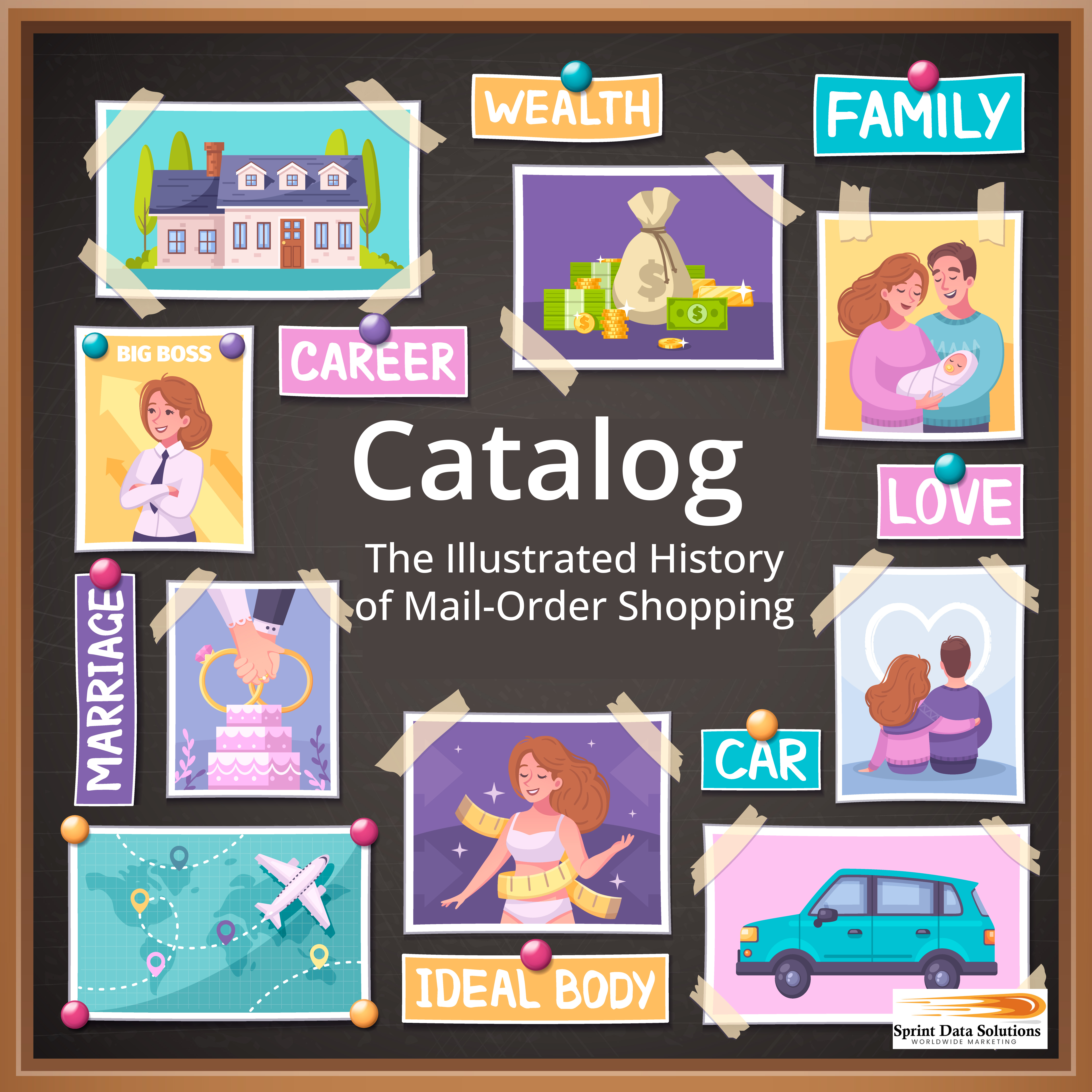Catalog & Magazine Mailing List
The 21st century has dramatically transformed the way people engage in everyday activities, and shopping is a prime example. Where once generations of Americans visited brick-and-mortar stores—from local markets to sprawling shopping malls—to browse and buy in person, today’s consumers have largely embraced the convenience of online shopping. Through mobile apps, websites, and even social media platforms, buyers can explore a virtually unlimited inventory and have items delivered directly to their doors. Yet, despite this digital shift, a surprising and enduring element remains relevant: the catalog. While it may seem like a relic of the past, the catalog has evolved and found renewed purpose, both in print and digital formats. It continues to serve as a powerful tool for showcasing curated product collections, seasonal offerings, and exclusive deals—providing a tactile or visual experience that online searches often lack.
The catalog’s enduring presence speaks to a deeper marketing truth: well-organized, visually engaging formats still play a key role in influencing purchasing decisions. Modern retail websites owe much of their structure to the catalog model, borrowing layouts, categories, and product descriptions from their printed predecessors. Furthermore, catalogs often go hand-in-hand with lifestyle magazines, allowing companies to create immersive brand experiences that connect emotionally with consumers. These materials don’t just advertise products—they tell stories, build aspiration, and often appeal to niche or loyal audiences. For companies aiming to tap into this resilient marketing channel, Sprint Data Solutions Worldwide Marketing offers robust support. With access to finely segmented consumer databases—including catalog and magazine readers—Sprint Data Solutions helps businesses deliver their message directly to those most likely to respond, maximizing reach and engagement in both digital and print marketing campaigns.
The Sprint Data Solutions Worldwide Marketing Story
Sprint Data Solutions Worldwide Marketing is an entirely American business owned and operated by a disabled veteran. Having completed the responsibilities of defending the country, it was decided that the next step should be a move away from defense and into growth. However, this growth would be economical and aimed at starting a business that would help the American business community grow. Sprint Data Solutions Worldwide Marketing was conceived from that idea and began operations in the home region of Las Vegas, Nevada. Now, after years of steady growth and success, the management of this enterprise proudly boasts a staff with over 50 years of combined marketing and sales sector experience.
At the beginning of Sprint Data Solutions Worldwide operations, marketing was still mainly in the traditional, analog era, with older platforms such as print and television advertising dominating the field. The company chose to specialize in print marketing, known as direct mail. Over the decades, direct mail has remained an effective form of marketing, and it continues to be a fixture of Sprint Data Solutions Worldwide Marketing even today.
Sprint Data Solutions Worldwide Marketing’s success demanded expanding services as time passed. The company eventually served the entire state from an initial service range of Las Vegas, Nevada. Then it went continental, filling every state on the mainland and all forms, including Hawaii and Alaska. Operations then expanded to provide complete North American coverage, serving the markets of Mexico and Canada. Finally, the company offered international options for those ready to do business on a global scale, reaching across the Atlantic and offering access to European Union markets such as France. All of this was done with direct mail. However, as the technology proved itself, the company began offering digital marketing services to serve the growing and dynamic market of computer-based and online marketing strategies.

The Catalog & Magazine Advantage
The 21st century has dramatically transformed the way people engage in everyday activities, and shopping is a prime example. Where once generations of Americans visited brick-and-mortar stores—from local markets to sprawling shopping malls—to browse and buy in person, today’s consumers have largely embraced the convenience of online shopping. Through mobile apps, websites, and even social media platforms, buyers can explore a virtually unlimited inventory and have items delivered directly to their doors. Yet, despite this digital shift, a surprising and enduring element remains relevant: the catalog. While it may seem like a relic of the past, the catalog has evolved and found renewed purpose, both in print and digital formats. It continues to serve as a powerful tool for showcasing curated product collections, seasonal offerings, and exclusive deals—providing a tactile or visual experience that online searches often lack.
The catalog’s enduring presence speaks to a deeper marketing truth: well-organized, visually engaging formats still play a key role in influencing purchasing decisions. Modern retail websites owe much of their structure to the catalog model, borrowing layouts, categories, and product descriptions from their printed predecessors. Furthermore, catalogs often go hand-in-hand with lifestyle magazines, allowing companies to create immersive brand experiences that connect emotionally with consumers. These materials don’t just advertise products—they tell stories, build aspiration, and often appeal to niche or loyal audiences. For companies aiming to tap into this resilient marketing channel, Sprint Data Solutions Worldwide Marketing offers robust support. With access to finely segmented consumer databases—including catalog and magazine readers—Sprint Data Solutions helps businesses deliver their message directly to those most likely to respond, maximizing reach and engagement in both digital and print marketing campaigns.
Home Cooking Magazines
The COVID-19 pandemic significantly altered everyday habits, including how often people dine out. While restrictions have eased and restaurants have reopened, many individuals have maintained the practice of preparing meals at home. Rising food prices and inflation have made eating out less appealing from a financial standpoint, pushing households to prioritize budgeting and home-cooked meals. In this context, cooking magazines have seen renewed value. Unlike digital devices, which can be fragile, distracting, or vulnerable to kitchen messes, physical magazines are easy to flip through, durable, and more convenient for quick reference while cooking. Beyond just recipes, many of these magazines also offer helpful meal planning tips, seasonal ingredient guides, and cost-saving techniques, making them an essential and budget-friendly tool for anyone looking to eat well without overspending.
Fine Wines
Wine is more than just a beverage—it’s a lifestyle, a deeply rooted cultural tradition, and for some, a serious investment. Enthusiasts of wine appreciate it not only for its taste but for its story, its origin, and the craft that goes into every bottle. Because of its rich heritage and nuanced complexity, wine continues to command attention in both print and digital publications. Catalogs and magazines dedicated to wine remain popular among collectors, connoisseurs, and casual drinkers alike, as they offer a blend of visual appeal, expert insights, and discovery of new or rare vintages. High-quality wine publications go beyond merely listing products; they educate their readers, providing in-depth features on grape varietals, winemaking regions, tasting techniques, and profiles of iconic vineyards and winemakers. Marketing strategies within the wine industry must cater to a wide economic range, from affordable table wines suited for daily enjoyment to rare, limited-production vintages that appeal to elite collectors. Specialty offerings like organic wines, biodynamic blends, or dessert wines such as ice wine also hold niche appeal and are often showcased in celebratory or seasonal promotions. Because wine appreciation often intersects with travel, food, and fine living, successful wine magazines often incorporate broader lifestyle content—highlighting pairing ideas, culinary recipes, and travel features about renowned wine regions like Bordeaux, Napa Valley, or Tuscany. The legacy, craftsmanship, and evolving innovation of wine all contribute to the enduring popularity of wine-centered content, making well-crafted magazines and catalogs essential for anyone serious about the wine world.

Cigars
Cigars, much like fine wine, are often regarded as premium indulgences tied to luxury, sophistication, and ritual. Their appeal transcends trends, with a rich history that spans cultures and centuries, from the ceremonial smokes of indigenous peoples to the refined lounges of modern connoisseurs. Unlike cigarettes, cigars are typically enjoyed more sparingly, emphasizing quality over quantity. Each cigar offers a unique flavor profile shaped by factors like region, climate, fermentation, and rolling technique—much like terroir in wine. This cultivates an environment of exploration and appreciation, where seasoned aficionados and curious newcomers alike are drawn to experiment with new blends, brands, and formats. As consumables, cigars naturally require replenishment, making repeat purchases likely, especially when paired with expert recommendations or compelling storytelling. Effective cigar marketing often hinges on refined presentation, detailed tasting notes, lifestyle branding, and educational content that highlights origin stories, craftsmanship, and pairing suggestions. When directed at the right audience—whether collectors, luxury lifestyle enthusiasts, or social smokers—these strategies can drive loyalty, curiosity, and strong sales.
Household Goods
Homes depend on a wide variety of products and services to function efficiently and comfortably. From everyday essentials like dishwashing liquid, laundry detergent, and toilet paper, to seasonal necessities such as sidewalk salt, dehumidifiers, or air purifiers, each room in the house has its own unique demands. The kitchen alone may require everything from cleaning sprays to food storage solutions, while bathrooms need a steady supply of toiletries and hygiene products. Bedrooms benefit from organizational tools and bedding essentials, and utility areas often need maintenance supplies or repair tools. Catalogs are especially helpful in offering a centralized resource where homeowners can browse and purchase these necessities all in one place, often grouped by room or function for easy navigation. Meanwhile, magazines not only introduce readers to the latest and most effective home care products but also provide expert tips, comparisons, and innovative techniques to improve everyday living—whether it’s maximizing storage, boosting energy efficiency, or enhancing aesthetic appeal. Together, these resources support homeowners in maintaining a well-stocked, well-managed, and smoothly running household.
Children’s Products
The market for children’s products is vast and continually evolving, encompassing everything from educational tools and learning services to health-conscious nutrition options, toys, clothing, and entertainment. As families seek high-quality, age-appropriate solutions for their children, businesses in this space have abundant opportunities for innovation and engagement. Catalogs featuring children’s products can span a wide range of themes—early learning, outdoor play, creative arts, tech gadgets for kids, and more. However, children’s magazines offer a particularly unique platform. These publications not only entertain and educate young readers but also serve as a trusted source of discovery for parents. Through curated content, product features, and activity-based learning, children’s magazines subtly introduce new products in a context parents find valuable and trustworthy. Parents are consistently open to fresh ideas that enrich their children’s lives and make parenting more effective and enjoyable, making these magazines an ideal avenue for targeted marketing and brand visibility.
CBD Oil & CBD Creams
As laws around cannabis continue to evolve across the United States, cannabidiol (CBD)—a non-intoxicating compound derived from the cannabis plant—has surged in popularity as a versatile wellness product. Unlike THC, the psychoactive element in cannabis, CBD does not produce a “high,” making it suitable for a broad range of therapeutic applications. Its benefits are now widely recognized in addressing issues such as anxiety, chronic pain, inflammation, and digestive discomfort, not only for people but also for pets. This wide array of uses makes CBD an ideal product to be promoted through both lifestyle magazines and targeted product catalogs, where it can be showcased in context with wellness, fitness, and senior care. However, marketing CBD oil and related products effectively requires strategic segmentation. Older adults are increasingly turning to CBD for relief from arthritis, joint pain, and sleep disorders, while younger demographics, including athletes, often seek out fast-acting topical CBD balms and creams to aid in post-workout recovery. Each of these groups has distinct needs, motivations, and buying behaviors, so a one-size-fits-all approach is ineffective. Tailoring content and product recommendations to each audience—whether through targeted print publications or digital catalog experiences—can significantly enhance engagement, trust, and conversions.
Sports Magazines & Products
Sports have long held a significant place in media, with dedicated magazines providing fans and athletes alike with in-depth coverage of games, player statistics, training techniques, and behind-the-scenes insights. This demand for comprehensive sports information remains strong across all types of sports, from mainstream favorites like basketball and football to more specialized pursuits such as curling, fencing, or bobsledding. Each sport has its own dedicated community eager for updates, analysis, and exclusive features that go beyond what daily news or live broadcasts can offer. At the same time, the sporting goods industry continues to thrive, fueled by both professional athletes and everyday enthusiasts seeking performance-enhancing gear, apparel, and accessories. Magazines and catalogs tailored to specific sports play a crucial role in guiding purchasing decisions, offering detailed product breakdowns, reviews, and comparisons that help consumers make informed choices. By carefully matching the right products and publications to each sport’s unique audience, businesses can effectively engage their target market and build lasting brand loyalty among fans who are always looking for ways to improve their game and deepen their involvement in the sports they love.
Seeds & Plants
Gardening has long been a cherished part of American home life, offering not only a rewarding pastime but also practical benefits such as home-grown produce and aesthetic landscaping. In recent years, however, interest in gardening has seen a significant resurgence, driven by a growing emphasis on sustainability, environmental awareness, and self-reliance. Rising grocery costs and concerns over food security have also prompted many individuals and families to explore the benefits of growing their own fruits, vegetables, herbs, and ornamental plants. As a result, the demand for seeds, starter plants, and gardening supplies has expanded across all experience levels—from complete beginners planting their first tomato seedling to seasoned horticulturists experimenting with heirloom varieties, organic techniques, or hydroponic systems. This renewed enthusiasm for gardening has created opportunities for businesses to offer a wide range of products and services, including seed subscriptions, gardening kits, composting systems, soil testing, vertical garden installations, and expert consultations. Whether it’s a small balcony garden in an urban apartment or a full backyard greenhouse, today’s gardeners are eager for innovative, convenient, and eco-friendly solutions that match their goals and lifestyles.
Collectibles
A massive and highly high segment of the consumer demographic is enthusiastic about collectibles, but only specific collectibles. For example, there’s an enormous difference in the interests and purchasing habits of someone who collects stamps versus a vinyl enthusiast collecting both new and vintage music pressings. Both differ significantly from a “retro gamer contain selects old video game hardware and software from the 1980s and 1990s.
Therefore catalogs and magazines for collectibles must strive for specificity. A stamp catalog will get zero interest from a retro gamer, and a magazine about retro games will not appeal to a vinyl collector. On the other side of the equation, however, there is a high level of interest, engagement, and response when suitable collectible marketing material is presented to the right collector.

Clothing & Fashion
Clothing remains a significant sign of purchases and has been a staple of catalog offerings for decades. Today, this hasn’t changed, as dress constitutes a substantial portion of both catalog and online sales—Sprint Data Catalog Mail Order buyers and RESPONDERS who like to shop. However, the types of clothing that get purchased vary wildly based on the interest and needs of customers. Professional attire is often valued more for its durability and protective qualities than purely for fashion.
One thing that always matters, however, is an image. Clothing, especially, does well in catalogs and magazines when there’s a willingness to invest in quality photography. With the right photos and presentation, clothing is always a good staple for catalog and magazine sales, especially when accompanied by compelling fashion or utility content about the clothing.
Home Improvement
While working with professionals gets good home improvement and renovation results, this can also be a significant investment. It’s one reason “Do It Yourself” or DIY home improvement remains a popular alternative. For businesses that offer home improvement-related products or services, working directly with the consumer can be lucrative if they can be reached.
For homeowners, there’s always an item—or several—that can stand to be repaired or, in some more ambitious cases, renovated or remodeled, which, done right, can add significant value to a property. Home improvement is a thriving industry with many different aspects, such as complete kitchen remodels, adding new half-bathrooms, or even repairing foundations. There’s plenty of room here for marketing.
Precision Marketing
The chief factor for success with marketing based on catalogs, magazines, or other types of traditional print marketing is striving for a realistic response rate. No matter how appealing marketing may be, a 100% response rate will never happen. Still, there are precautions a business can take to raise the likelihood of a response instead of being ignored.
Businesses should not take a large-scale, scattershot approach if they are trying to maximize their response rate. For example, while it is certainly possible to pay for a list of hundreds of thousands of mailing addresses and then send hundreds of thousands of catalogs, this only guarantees hundreds of thousands of orders from those catalogs. Suppose a record offers children’s products, and a large segment of the recipients that were mailed are single and childless, such as college students. In that case, it’s statistically inevitable that the response will be low. This market has no need or interest in what is being offered.
Conversely, if a catalog offers products for young children, and only addresses confirmed to have families with children currently between the ages of 2-10 are targeted, even if this is only 20000 addresses versus 100000 college students.
On the other hand, if you gain access to a mailing list of parents with children between the ages of 2-10, even if it’s only a few thousand names, the response rate is much more likely to be higher. It seems counter-intuitive, but marketing to fewer people with high interest often results in better response rates than marketing to many people with little to no interest. Precision, not generality, generates engagement, response, and sales.
We’re Here To Help
Over the years, Sprint Data Solutions Worldwide Marketing has compiled and maintained massive databases for various consumer and B2B needs. More importantly, it has also been meticulous about keeping these databases up to date, preventing inefficiencies from creeping in, such as sending marketing to a deceased recipient or to a specialist enthusiast who resides at a given address.
The contact details for lists are now much more varied, which Sprint Data Solutions Worldwide Marketing needs to understand and be prepared to accommodate. It’s no longer just physical mailing addresses that get the job done. Now an array of communication channels can be utilized, like telephone numbers for voice calls, email addresses for digital marketing, and even cellular phone numbers for text/SMS messaging.
Find The Right List For You
Whether you’re looking for a catalog and magazine buyers mailing list, a catalog shopper mailing list, or a list for mail-order buyers, Sprint Data Solutions Worldwide Marketing has the data you need. The categorical breakdowns for different databases are extensive and get into organized detail for consumer and B2B marketing needs. In terms of geography, listings are easily scalable. Businesses can take a nationwide approach if that’s the level of ambition or scope things down to a regional level, such as only approaching catalog buyers within the New England area. It can go even narrower, providing single state or single town or city addresses. Even specific neighborhoods can be targeted if there’s a need for local advertising that keeps things small.
We also have extensive databases in specific demographics based on a wide range of different profile characteristics. These databases, like our other data, these metrics are carefully compiled, then continuously evaluated to ensure the currency so the contact details are still of use to our clients. Sprint Data Worldwide Marketing uses a broad range of different characteristics for profiles, such as:
- Age
- Ethnicity
- Debt
- Age of Children
- Renter
- Homeowner
- Income
- Marital Status
- Mortgage Data
- Geography
- Veteran Status
- Big & Tall Mail Order Buyers
And that’s just the beginning. With access to finely segmented consumer and business databases, you can target audiences ranging from broad nationwide groups to niche interests defined by age, income, lifestyle, or specific buying behaviors. Whether you’re distributing luxury fashion catalogs or specialized hobby magazines, we ensure your materials reach readers who are most likely to engage. At Sprint Data Solutions Worldwide Marketing, we specialize in helping you connect with the right audience to maximize impact and ROI. Trust us to deliver the catalog and magazine direct mail lists that convert interest into action.






